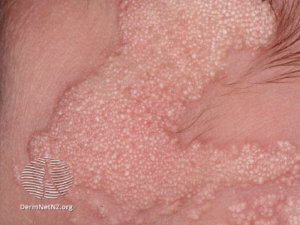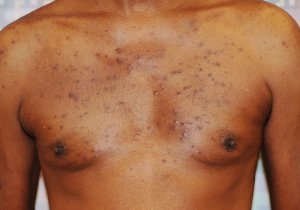Milia Treatments from U.S. Dermatology Partners
Milia (Milium) Symptoms & Causes
Milia is a commonly occurring skin condition that causes small bumps on the skin, and while these bumps may be irritating, the skin condition is harmless. You can learn more about milia, how it’s treated, and when to visit your dermatologist for help managing this skin condition on this page. If you have questions or want to schedule an appointment at U.S. Dermatology Partners, we invite you to take a few moments to complete our simple online request form.
Find This Service Near You
What are Milia?
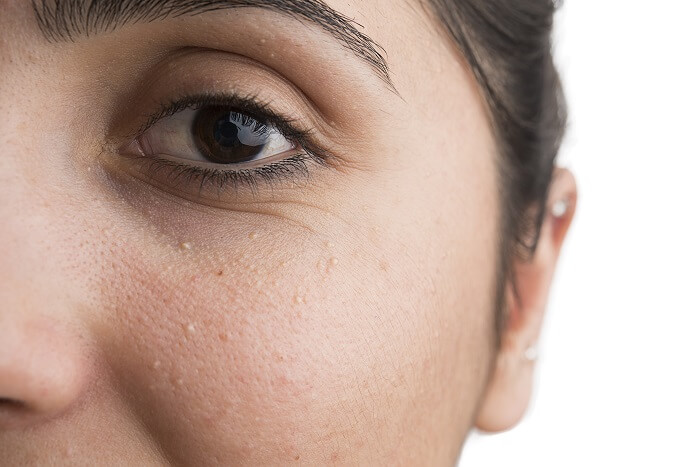
Are There Different Types of Milia?
There are several different types of milia that are grouped according to the life stage when they develop and/or their underlying causes.
You can learn more about each of the six types of milia below:
 Neonatal Milia
Neonatal Milia
By far the most common form of milia, neonatal milia affects as much as 50% of children, and you may have heard these bumps referred to as milk spots. Neonatal milia is often mistaken for baby acne. However, just like milia that develops in adults and teens, these bumps are not acne, but small cysts. Milia cysts in infants usually clear up on their own.
 Juvenile Milia
Juvenile Milia
Juvenile milia is usually a symptom that results from genetic conditions, including:
- Gardner Syndrome
- Nevoid Basal Cell Carcinoma Syndrome
- Pachyonychia Congenita
- Bazex-Dupre-Christol Syndrome
 Primary Milia
Primary Milia
Primary milia usually occurs in older kids, teens, and adults. This condition occurs when keratin builds up below the skin on the eyelids, forehead, nose, and cheeks. Like neonatal milia, this condition typically clears up on its own, but it can take several weeks or months for the skin to completely heal.
Secondary Milia
Secondary milia usually develops after an infection, injury, burn, blister, or severe rash like those caused by poison oak, ivy, and sumac. It can also occur after long term sun damage or after the prolonged use of corticosteroids. These conditions and medications can damage the lining of pores or clog the sweat ducts. Then, while the skin is healing, milia form in the damaged areas.
Milia en Plaque
This is a very rare form of milia. Like juvenile milia, the cause of milia en plaque is typically attributed to genetic conditions or autoimmune disorders, including discoid lupus and lichen planus. Milia en plaque is most common in middle-aged women, and the small milia cysts usually develop on the eyelids, cheeks, jawline, and around the ears. These milia typically develop on thickened, inflamed areas of skin commonly referred to as plaques.
Multiple Eruptive Milia
Multiple eruptive milia is a rare and often serious form of the condition that can cause milia to develop on the face, arms, chest, shoulders, and upper torso. The milia can develop over several weeks or months and be very itchy, irritating the affected skin and surrounding areas.
Who is at Risk for Milia?

While there’s not usually one cause for milia development, risk factors for this condition include:
- Poor quality sleep or lack of sleep
- Ineffective skincare routines or poor personal hygiene
- Oil-based cosmetics or skincare products, especially when used frequently
- Oral or topical steroid usage
What are the Symptoms of Milia?
The most common warning sign of this condition is the milia cysts themselves. Milia can look like whiteheads, and people often mistake them for breakouts, especially if they develop in areas where acne breakouts often occur. The cysts are usually white or yellow-colored. If milia develop on or around the eyes or nose, they can be annoying. However, the milia cysts don’t usually itch or cause any discomfort, and they are not harmful to your health. Milia impact the appearance and texture of the skin, and they are often described as feeling like seeds trapped beneath the skin.
What are the Treatment Options for Milia?
It can be tempting to try “popping” milia like pimples, but home extraction is never recommended for pimples or milia. In fact, you aren’t likely to be very successful if you try popping milia. Instead, there are some home care techniques and professional treatments available to safely and effectively remove milia cysts.
At-Home Milia Treatment
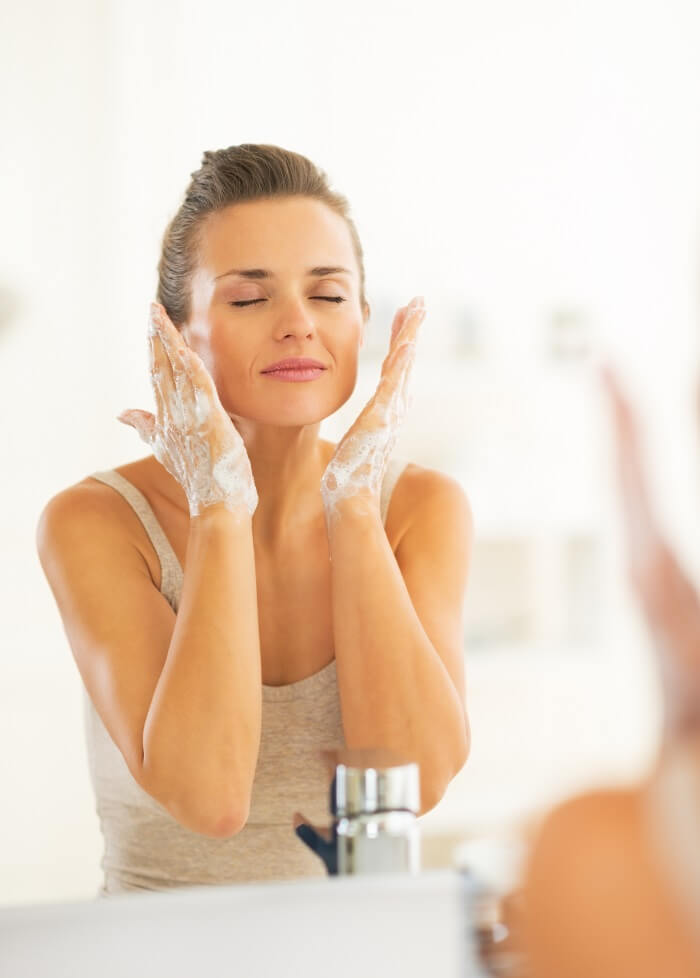
For other forms of milia or primary milia that are irritating, developing in uncomfortable areas, or that significantly mar the appearance, you can try to accelerate milia clearance with at-home skincare treatments, including:
- Exfoliation – Use a gentle, chemical exfoliation product with salicylic, citric, or glycolic acid to remove dead skin cells and stimulate healthy cell turnover. Don’t over-exfoliate, which can irritate the skin. Once or twice a week is usually plenty to prevent milia development and diminish the appearance of existing milia.
- Facial peels – This is a good option for primary milia, but it may actually exacerbate secondary milia and other forms of this skin condition. Always ask your dermatologist before performing chemical peels at home or simply schedule this treatment with a professional. At-home facial peel products usually contain higher concentrations of salicylic or glycolic acid than exfoliants, and when applied to the skin, they peel away the top layers.
- Retinoid spot treatments – Retinoids are topical skin treatments that contain vitamin A, which is important for maintaining healthy skin because it encourages healthy cell turnover. These spot treatments should be applied to the area affected by milia once a day, typically before bed.
Dermatologist Treatments for Milia

There are many different treatment options available from your dermatologist for milia, including:
- Comedone extractor therapy – Using a small, specialized needle or lancing tool to remove individual cysts
- Cryotherapy – Using extreme cold to freeze away cysts
- Curettage and cautery – Using heat to remove cysts and cauterize the treatment area
- Laser therapy – Using a laser to destroy the cyst contents and resurface skin
- Dermabrasion – Using a specialized instrument to remove the outer layers of skin
- Chemical peels – Like at-home peels, in-office treatments use chemicals to remove the outer layers of skin, revealing healthier skin below
- Tretinoin – A high dosage, topical retinoid cream that is often prescribed for the treatment of milia en plaque
- Oral antibiotics – Typically prescribed in combination with topical tretinoin for the treatment of milia en plaque
Can Milia be Prevented?
It’s unlikely that you can prevent milia altogether, but you can take some steps to significantly diminish your risk, including:
- Clean skin – Make sure you gently cleanse the skin twice a day and completely dry the skin after cleansing to prevent drying out.
- Exfoliate – Two or three times a week, you should exfoliate the skin to prevent the buildup of dry skin cells that may become trapped, forming milia.
- Retinol – Use a small amount of retinol (a less potent form of the ingredients in retinoid spot treatments) every other day to create healthy cell turnover and minimize risk for milia.
- Steam – This removes irritants from the skin and helps to keep pores open, preventing milia development. There are steaming devices available for purchase, or you can create steam by running a warm bath or shower and sitting in the steam. To steam your face, it’s often just as effective to simply fill a bowl with very hot water. Then, position your face a few inches over the bowl and place a towel over your head and the warm water to trap steam against the skin.
- Sun protection – It’s no surprise that dermatologists recommend keeping skin safe from sun damage for all patients, but this can be especially important for individuals who are prone to developing milia. Sun-damaged skin is often at risk for secondary milia production. Choose a good quality, lightweight sunscreen or sunblock with an SPF of 30 or higher, and apply this sunscreen before sun exposure.
Is Milia Treatment Permanent?
The vast majority of milia will clear on their own after a few weeks, and in infants, the condition does not typically recur. After milia are removed or skin heals, following a skincare routine outlined by your dermatologist will typically help you prevent future milia flareups.
*Results may vary by individual

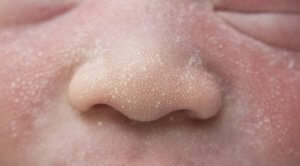 Neonatal Milia
Neonatal Milia Juvenile Milia
Juvenile Milia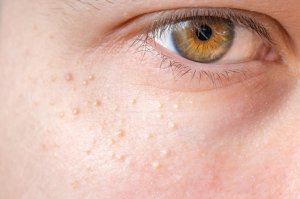 Primary Milia
Primary Milia
